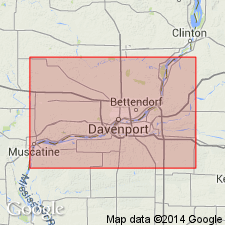
- Usage in publication:
-
- Gower stage
- Modifications:
-
- Original reference
- Dominant lithology:
-
- Dolomite
- AAPG geologic province:
-
- Iowa shelf
Summary:
Pg. 422, 423. Gower stage. Limestones constituting upper stage of Niagara series, and all of Niagara present in Scott County, the lower (Delaware) stage of Niagara not being recognized. Includes lithological varieties of rocks which have been called Anamosa substage and LeClaire limestone, but which are contemporaneous [?]. Overlain by Devonian Wapsipinicon limestone.
Named from Gower Twp., Cedar Co., central eastern IA.
Source: US geologic names lexicon (USGS Bull. 896, p. 845-846).

- Usage in publication:
-
- Gower Formation
- Modifications:
-
- Areal extent
- AAPG geologic province:
-
- Iowa shelf
- Wisconsin arch
Summary:
According to author, one of his primary aims in this report is to strongly encourage adoption of IA nomenclature in adjacent IL. The only major change is the incorporation of the Sweeney and Marcus as members within the Hopkinton and replacement of the Racine with upper members of the Hopkinton, the Scotch Grove Formation, and the Gower Formation. The Gower is over 150 ft thick in the Quad Cities area. The dominant facies is the Anamosa Member, which is characterized by flat-lying laminated dolomite. The eastward extent of the Anamosa strata in IL is not known with certainty, but the study area is probably the eastern limit. Laminated Anamosa strata interbed complexly with the LeClaire Member in the Quad Cities area. The LeClaire represents complex carbonate mound and bank facies. The name LeClaire has been used in the area since 1858 and has clear stratigraphic precedence over any subsequent term applied to equivalent strata in the area, including the Port Byron and Racine Formations. The Gower unconformably underlies the Middle Devonian Wapsipinicon Group or Pennsylvanian shale or sandstone. The Gower is approximately mid-Wenlockian in age at its base, and may be Ludlovian in its upper part.
Source: GNU records (USGS DDS-6; Reston GNULEX).
For more information, please contact Nancy Stamm, Geologic Names Committee Secretary.
Asterisk (*) indicates published by U.S. Geological Survey authors.
"No current usage" (†) implies that a name has been abandoned or has fallen into disuse. Former usage and, if known, replacement name given in parentheses ( ).
Slash (/) indicates name conflicts with nomenclatural guidelines (CSN, 1933; ACSN, 1961, 1970; NACSN, 1983, 2005, 2021). May be explained within brackets ([ ]).

